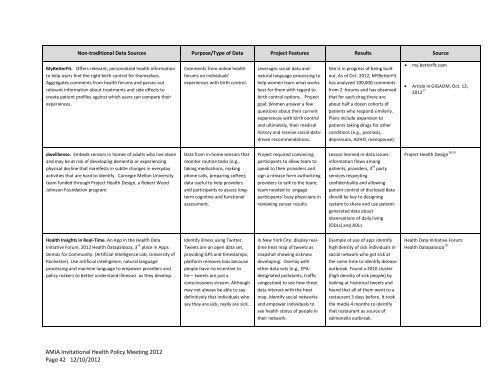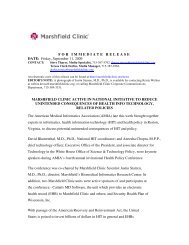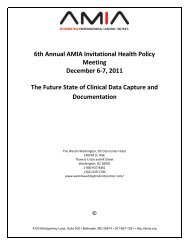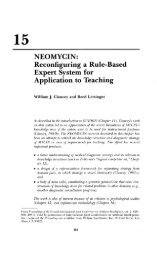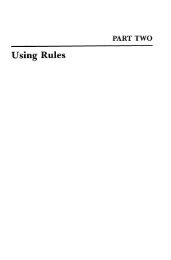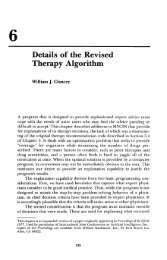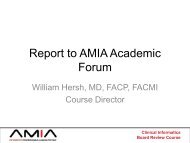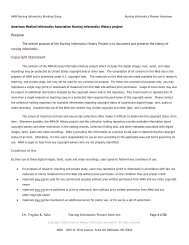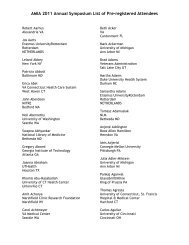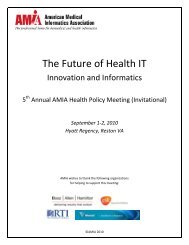7th Annual AMIA Invitational Health Policy Meeting December 12-13 ...
7th Annual AMIA Invitational Health Policy Meeting December 12-13 ...
7th Annual AMIA Invitational Health Policy Meeting December 12-13 ...
You also want an ePaper? Increase the reach of your titles
YUMPU automatically turns print PDFs into web optimized ePapers that Google loves.
Non-traditional Data Sources Purpose/Type of Data Project Features Results Source<br />
MyBetterFit. Offers relevant, personalized health information<br />
to help users find the right birth control for themselves.<br />
Aggregates comments from health forums and parses out<br />
relevant information about treatments and side effects to<br />
create patient profiles against which users can compare their<br />
experiences.<br />
dwellSense. Embeds sensors in homes of adults who live alone<br />
and may be at risk of developing dementia or experiencing<br />
physical decline that manifests in subtle changes in everyday<br />
activities that are hard to identify. Carnegie Mellon University<br />
team funded through Project <strong>Health</strong> Design, a Robert Wood<br />
Johnson Foundation program.<br />
<strong>Health</strong> Insights in Real-Time. An App in the <strong>Health</strong> Data<br />
Initiative Forum, 20<strong>12</strong> <strong>Health</strong> Datapalooza, 3 rd place in Apps<br />
Demos for Community. (Artificial Intelligence Lab, University of<br />
Rochester). Use artificial intelligence, natural language<br />
processing and machine language to empower providers and<br />
policy makers to better understand illnesses as they develop.<br />
<strong>AMIA</strong> <strong>Invitational</strong> <strong>Health</strong> <strong>Policy</strong> <strong>Meeting</strong> 20<strong>12</strong><br />
Page 42 <strong>12</strong>/10/20<strong>12</strong><br />
Comments from online health<br />
forums on individuals’<br />
experiences with birth control.<br />
Data from in-home sensors that<br />
monitor routine tasks (e.g.,<br />
taking medications, making<br />
phone calls, preparing coffee);<br />
data useful to help providers<br />
and participants to assess longterm<br />
cognitive and functional<br />
assessment.<br />
Identify illness using Twitter.<br />
Tweets are an open data set,<br />
providing GPS and timestamps;<br />
platform removes bias because<br />
people have no incentive to<br />
lie— tweets are just a<br />
consciousness stream. Although<br />
may not always be able to say<br />
definitively that individuals who<br />
say they are sick, really are sick.<br />
Leverages social data and<br />
natural language processing to<br />
help women learn what works<br />
best for them with regard to<br />
birth control options. Project<br />
goal: Women answer a few<br />
questions about their current<br />
experiences with birth control<br />
and ultimately, their medical<br />
history and receive social-datadriven<br />
recommendations.<br />
Project required convincing<br />
participants to allow team to<br />
speak to their providers and<br />
sign a release form authorizing<br />
providers to talk to the team;<br />
team needed to engage<br />
participants’ busy physicians in<br />
reviewing sensor results<br />
In New York City: display realtime<br />
heat map of tweets as<br />
snapshot showing sickness<br />
developing. Overlay with<br />
other data sets (e.g., EPAdesignated<br />
pollutants, traffic<br />
congestion) to see how these<br />
data interact with the heat<br />
map. Identify social networks<br />
and empower individuals to<br />
see health status of people in<br />
their network.<br />
Site is in progress of being built<br />
out. As of Oct. 20<strong>12</strong>, MYBetterFit<br />
has analyzed 100,000 comments<br />
from 2 forums and has observed<br />
that for each drug there are<br />
about half a dozen cohorts of<br />
patients who respond similarly.<br />
Plans include expansion to<br />
patients taking drugs for other<br />
conditions (e.g., psoriasis,<br />
depression, ADHD, menopause).<br />
Lesson learned re data issues:<br />
information flows among<br />
patients, providers, 3 rd party<br />
services respecting<br />
confidentiality and allowing<br />
patient control of disclosed data<br />
should be key to designing<br />
system to share and use patientgenerated<br />
data about<br />
observations of daily living<br />
(ODLs) and ADLs<br />
Example of use of app: identify<br />
high density of sick individuals in<br />
social network who got sick at<br />
the same time to identify disease<br />
outbreak. Found a 2010 cluster<br />
(high density of sick people) by<br />
looking at historical tweets and<br />
found that all of them went to a<br />
restaurant 3 days before. It took<br />
the media 4 months to identify<br />
that restaurant as source of<br />
salmonella outbreak.<br />
� my.betterfit.com<br />
� Article in GIGAOM, Oct. <strong>12</strong>,<br />
20<strong>12</strong> 17<br />
Project <strong>Health</strong> Design 18,19<br />
<strong>Health</strong> Data Initiative Forum:<br />
<strong>Health</strong> Datapalooza 20


